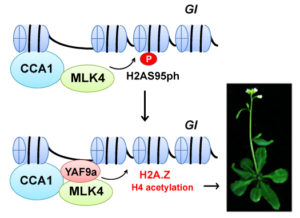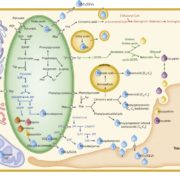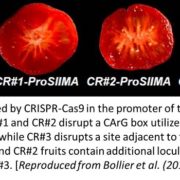How Does Histone Phosphorylation Affect Flowering Time?
Su et al. look at chromatin modifications that affect flowering. The Plant Cell 2017. https://doi.org/10.1105/tpc.17.00266
Plants, unlike animals, begin their lives as seeds that – in flowering plants – develop from flowers. This depends upon proper regulation of flowering time, to ensure pollination, fertilization, and development of the seed at the right time. In the long-day plant Arabidopsis thaliana, GIGANTEA (GI) protein activates CONSTANS (CO), which in turn upregulates FLOWERING LOCUS T (FT) to promote flowering under a long-day photoperiod. Thus regulation of GI is crucial to the process. CIRCADIAN CLOCK ASSOCIATED1 (CCA1) binds to GI and blocks its activation, but the activators of GI remain unclear.
In eukaryotic cells, covalent modifications in chromatin, such as histone phosphorylation and acetylation, participate in development by activating or blocking transcription of genes. Plants might have specific histone modification sites if chromatin truly contains developmental information. A primary question is how plant-specific histone modifications and other regulators work together to promote proper flowering time in Arabidopsis.
Su et al. found that the protein MUT9P-LIKE-KINASE (MLK4) promotes proper flowering time under a long-day photoperiod. MLK4 phosphorylates the histone H2A at serine 95, a site that exists in plants, but not in yeast, Drosophila, mouse, or humans. CCA1 interacts with MLK4, allowing it to to bind GI. Moreover, in vivo, MLK4 interacts with YAF9a, a subunit of a large protein complex that incorporate the histone variant H2A.Z into chromatin. The Arabidopsis mlk4 mutant exhibits a reduction in the levels of serine 95 phosphorylation of histone H2A, H2A.Z enrichment, and GI transcript, which in turn delays flowering time.
Curiously, MLK4 has no function in regulating flowering time under a short-day photoperiod. The authors hypothesized that MLK4 might have different mRNA levels or activities under long-day versus short-day photoperiods. Future studies will focus on understanding how this enzyme is regulated by photoperiod, because only plants that flower at the right time can generate seeds.
Su, Y.H., Wang, S.L., Zhang, F., Liu, Y.N., Huang, T.T., and Ding, Y. (2017) Phosphorylation of Histone H2A at Serine 95: a Plant-specific Mark Involved in Flowering Time Regulation and H2A.Z Deposition. Published August 2017. https://doi.org/10.1105/tpc.17.00266.









